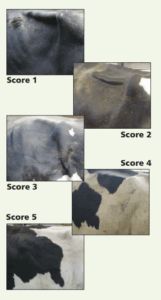Rumen fill refers to the degree to which the cow’s rumen appears full, typically assessed by observing the left flank of the cow. It indicates how much feed the cow has consumed and how well the rumen is functioning.
Why use Rumen Fill as a feeding guide?
- Visual Indicator: It provides a quick, non-invasive way to assess feeding status without
needing lab tests or equipment.
- Reflects Dry Matter Intake (DMI): A well-filled rumen suggests the cow is consuming
enough dry matter, which is crucial for milk production, health and overall performance. - Monitors Feeding Behaviour: Changes in rumen fill can indicate issues like feed
palatability, feed availability, cow comfort and can show weakness in feed management. - Detects Health or Management Problems:
- Illness (e.g., lameness, ketosis, displaced abomasum, acidosis)
- Poor feed quality or quantity
- Inadequate trough space or insufficient time to eat.
- Supports Transition Cow Management: Especially important during the transition
period, when feed intake can drop and metabolic disorders are common. - Helps Optimise Ration Formulation: If rumen fill is consistently low, it may suggest the
need to adjust fibre levels, energy density, or feeding frequency.
How to Score Rumen Fill
1 = Empty rumen (hollow left flank)
3 = Moderate fill (normal intake)
5 = Full rumen (rounded left flank)
A score of 3–4 is generally ideal for high-producing dairy cows
Score Descriptions
1 – Empty: Hollow left flank, poor intake, possible health issue.
2 – Slight Fill: Slight depression in flank, below optimal intake.
3 – Moderate Fill: Flat or slightly rounded flank, normal intake.
4 – Good Fill: Rounded flank, high intake, ideal for production.
5 – Full: Very rounded flank, possibly overfed or slow digestion.
Practical Tips for Observation
- Observe cows from the left side, ideally 2–4 hours after feeding.
- Ensure cows are standing and relaxed.
- Use consistent lighting and angle for comparison.
- Record scores regularly to monitor trends.
Using Scores to Adjust Feeding
Scores 1–2: Increase feed availability or check for health issues.
Score 3: Maintain current feeding strategy.
Scores 4–5: Evaluate fibre content or feeding frequency to avoid overfeeding.
